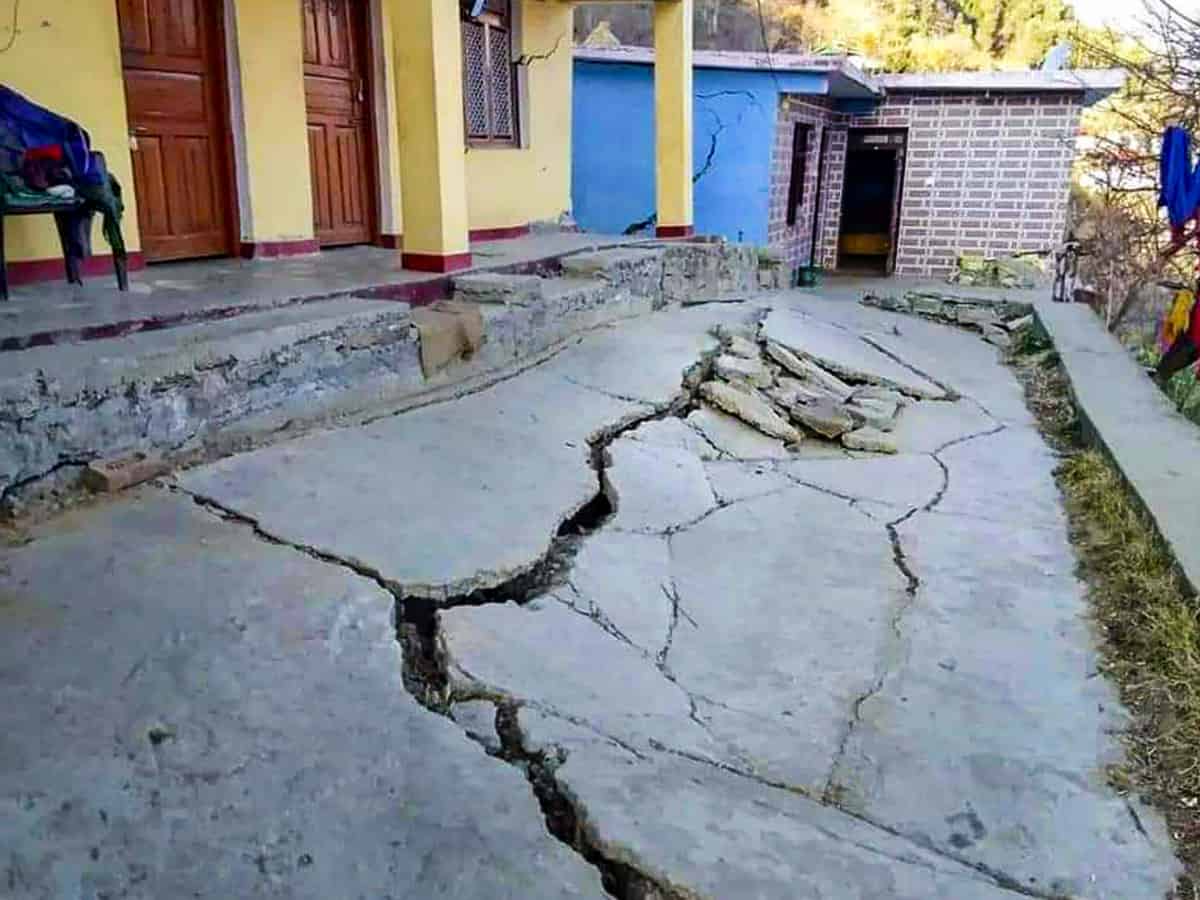
New Delhi: The appearance of cracks on roads and houses across Joshimath in Uttarakhand is mainly due to the rampant infrastructure development that is happening in a very fragile ecosystem like Himalayas, experts said on Sunday, adding climate change is a force multiplier.
However, a local environmental activist blamed the irreparable damage to several tunnels and hydropower projects in and around Joshimath. Their voices have been blatantly ignored, he added.
Saying Joshimath is a grave reminder that the local authorities are messing up with the environment to an extent that is irreversible, Anjal Prakash, Research Director and Adjunct Associate Professor, Bharti Institute of Public Policy, Indian School of Business and Lead Author for IPCC reports, told IANS climate change is becoming a reality.
“There are two aspects to Joshimath problem — first is rampant infrastructure development which is happening in a very fragile ecosystem like Himalayas and this is happening without much of a planning process in a way where we are able to protect the environment and at the same time bringing in basic infrastructure for the millions of people who are inhabitation in those areas.
“Secondly, climate change is a force multiplier. The way climate change is manifesting in some of the hill states is unprecedented. For example, 2021 and 2022 have been years of disaster for Uttarakhand. There have been numerous climate risk events recorded like high rainfall events triggering landslides.
“We have to first understand that these areas are very fragile and small changes or disturbances in the ecosystem will lead to grave disasters, which is what we are witnessing in Joshimath. In fact, this is a particular point in history which should be remembered as what should be done in the Himalayan region.”
According to the book ‘Central Himalaya’ by Heim, Arnold and August Gansser, Joshimath town of Chamoli district is situated on the debris of a landslide.
A few houses had already reported cracks back in 1971, post which a report had suggested few measures that included conservation of the existing trees and plantation of more trees, boulders on which the town is located should be touched and reinforced cement concrete (RCC) should not be done.
Y.P. Sundriyal, Head of Department of Geology, HNB Garhwal University, told IANS these measures were never followed. Several experts have cited that traditional housing construction technologies are able to withstand earthquakes and landslides much more strongly than the newly constructed infrastructures.
Talking about the present situation, he said, the ongoing crisis in Joshimath is primarily because of anthropogenic activities.
The population has increased manifold and so has the tourist landfall.
Infrastructure has also amplified and has been unchecked. However, the town does not have a proper drainage system.
Besides gradual weathering of fine material between the rocks of debris, water percolation has decreased the cohesive strength of the rocks over the time.
According to Sundriyal, this has resulted in landslides, triggering cracks in the houses.
Secondly, the construction of these tunnels for hydropower projects is being done through blasting, creating local earthquake tremors, shaking debris above the rocks, again leading to the cracks.
The Himalayas is a very fragile ecosystem. Most parts of Uttarakhand are either located in seismic zone V or IV which are prone to earthquakes.
Local environmental activist Atul Satti said they have been repeatedly warning authorities about the irreparable damage caused due to several tunnel and hydropower projects in and around Joshimath and other parts of Uttarakhand.
“However, our voices were blatantly ignored and our worst nightmare has come true today. The entire responsibility of Joshimath caving in is on NTPC’s Tapovan Vishnugad Hydro Power Project.
“Continuous blasting in the tunnels have shaken the foundation of our town. We demand instant action from the government that must include immediate stalling of NTPC project, closure of Chardham all-weather road (Haleng-Marwari Bypass), implementation of NTPC’s pact that insures houses, setting a committee for rehabilitation of Joshimath within a set timeframe.”
Giving scientific viewpoint, Research Director Prakash said he is convinced that the Joshimath caving incident is caused by the hydropower project which has been operational in building the tunnel and is the major cause of concern for residents.
It has shown that water which has gushed out is from a fractured zone which has been punctured by the tunnel that has been leading to the devastating situation.
“This is also in the pretext of several reports in the past. I would quote two reports of IPCC, published in 2019 and 2022, that have critically observed that this region is very prone to disasters. This means a very strong planning process must follow.”
“In fact, the entire planning should be done at the bio-regional scale that should include what is allowed and what is not and has to be very stringent. I am not against bringing infrastructural development for people as these are the places of tourist interest. I understand the fact that people in these places here have no other means of survival considering the religious place they are in.”
“However, it has to be done in a planned manner. We must leave out some things and look out for other ways for energy generation. The return investment cost in hydropower projects is very less when compared to the cost associated with environmental and ecological damage. Joshimath is a clear example of what one should not do in the Himalayas,” Prakash added.



